The DIY lithium battery bank; Bob Ebaugh has 330 cycles so far
Bob and Elaine Ebaugh did it, leaving Florida in April, 2011, on their DeFever 44 Mar Azul and spending more than two years cruising a big Caribbean loop. Their blog, Mar Azul Adventures, is a good read, but you might miss the fact that during the cruise Bob managed to research, assemble, test and install a 1,200 amp hour do-it-yourself lithium iron phosphate (LiFePO4) battery bank to replace the 12 golf cart batteries they’d worn out. He also wrote a thorough white paper about why he chose DIY lithium and how he put the system together…
Here is Bob’s lithium battery blog entry, but you really should download the 14-page PDF mentioned there. Even if you’re not ready to build your own LiFePO4 battery bank — and most of us probably shouldn’t at this point — Bob seems to have done a fine job of analyzing the pros and cons of different battery types, particularly for fairly heavy power users like Mar Azul (at 400-600 Ah per liveaboard day on the hook).
This photo shows the DeFever’s “workshop” (forward cabin). Bob’s first task was to assemble forty-eight individual 3.2V cells made in China by GB Systems into twelve 100 Amp hour 12V batteries, and here I believe he’s bench testing the Elite Power battery management system (BMS) whose components are seen below. His PDF gives specifics about where he sourced the GBS cells and BMS and why, as well as a link collection for further research.
There’s a lot to managing lithium batteries properly, and there’s a definite safety concern. Their wonderful ability to take a large charge quickly, thereby reducing generator and/or alternator times, also means that they can release their charge very quickly, which means intense heat in the wrong circumstances. There have apparently been boat fires that originated in lithium battery banks, though the facts usually seem hard to come by (possibly because most marine lithium installs so far have been high-end projects).
At any rate, I’d suggest that anyone (including myself) who doesn’t thoroughly understand Bob’s well-written explanation of how he set up his BMS, diagrammed above, and adjusted his various charging sources for their new LiFePO4 target should not consider a DIY lithium bank. But I’m really glad that guys like Bob are trying such things and sharing their findings. Note also that since coming back ashore, Bob has been doing marine electronics professionally and hopes to write a Panbo entry about a substantial ePlex distributed power system he’s working on, which will join his earlier pieces on bridging NMEA to Ethernet, his Chetco engine monitoring system, and testing various sat phone systems. Meanwhile, here’s the latest on Mar Azul’s lithium batteries:
The lithium bank is still functioning well. But I have not done any cruising for almost a year now, maybe 2 Saturday nights. I really like the operational characteristics, but the cards are still not all on the table.
About the only thing additional I completed {since writing the white paper} is a benchmark test on capacity. My theoretical 1200 Ah bank is really more like a 1050 Ah bank. So in one year of cruising, theoretically I lost about 15% of rated capacity. What I don’t have is an actual pre-installation benchmark, though the importer suggested that as shipped, and tested the way I did, they would have shown 95% of the rating; so maybe we only lost 10%. We did have 330 cycles in that timeframe.
Some research indicates capacity loss is also very related to calendar life and storage temperature. The end of August gives me another 12 months so I will run another test and see what we have now, with the bank essentially in storage.
There is so much we don’t know. Not only about “life”, but exactly how volatile they are if severely overcharged. This winter, I may buy a few 40Ah cells and do some destructive testing.
RC Collins is apparently also testing lithium marine batteries and he, Bob, and several other marine power luminaries sit on a ABYC subcommittee studying LFP (another name for LiFePO4) battery technology under the chairmanship of Bob’s current boss/mentor Charlie Johnson. Thanks to them all, and don’t we look forward to hearing the results?


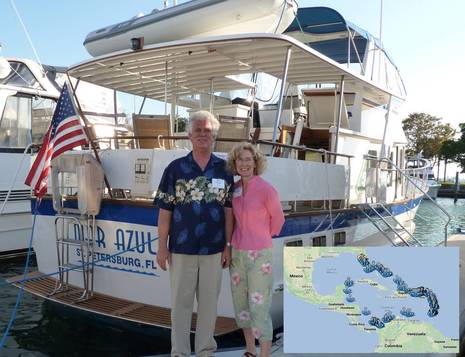
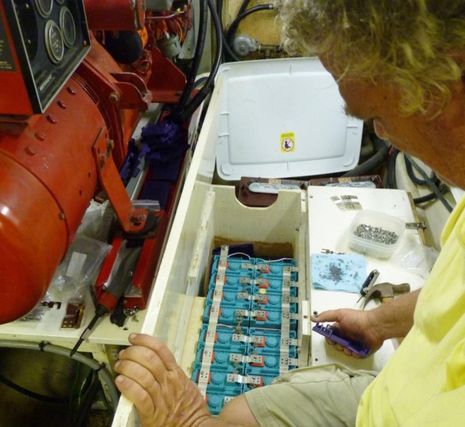
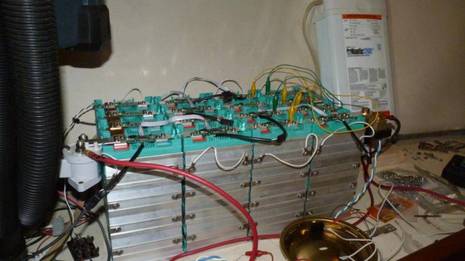
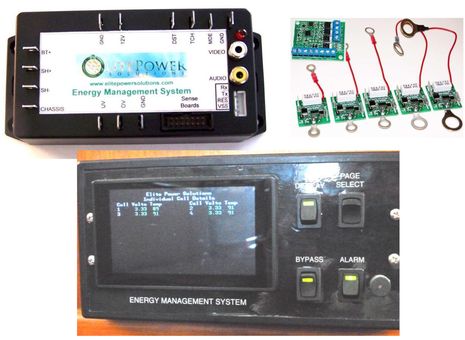



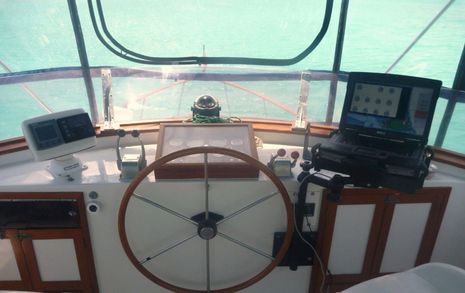
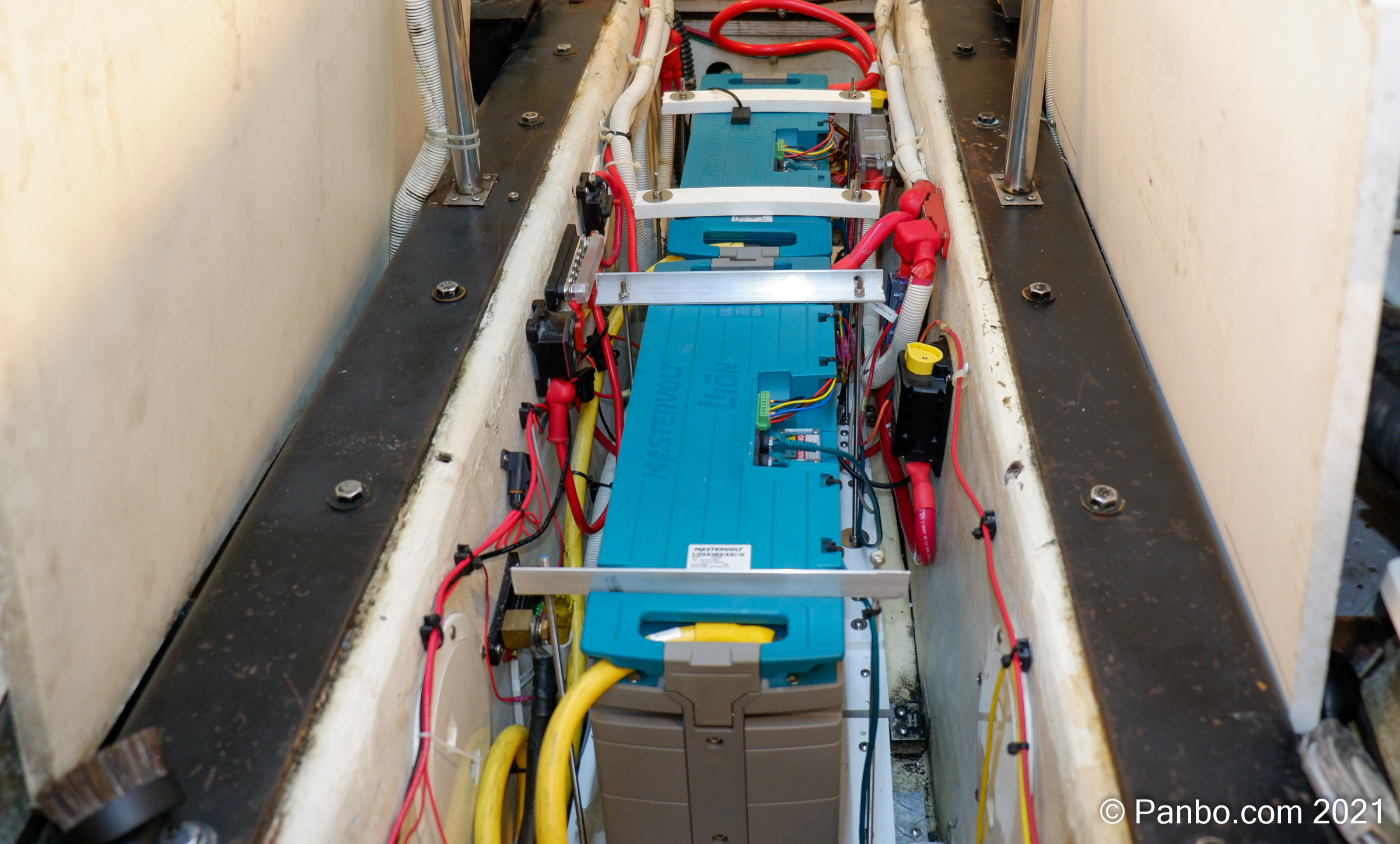
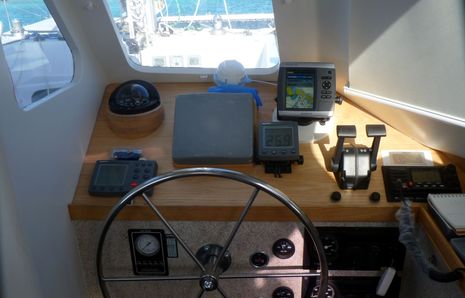








So what to we think 2 years later? A bit more detail than I provided Ben in the email he quoted above.
The operational characteristics for live aboard at anchor are nothing short of phenomenal. No more worries about full charging or periodic equalization. Just use what energy you need and put it back when you can. And you always get to put it back at full rate!
M/V Mar Azul is an incredibly power hungry vessel for living at anchor. We destroyed 12 Trojan T105’s getting from Florida to Grenada. The boat uses an average of 20-25A at 12V at anchor, mostly running inefficient refrigeration. 3 systems, 2 fridges and one chest freezer. Operationally after returning, the LFP system appears to operate like the day we installed it.
But…I wanted to establish a baseline capacity test. Cycle life is the holy grail to justification of the cost and effort of installing LFP. So shortly after we got back I purchased a battery tool that allowed me to capture the data during charge discharge cycles with the batteries removed from the boat on the bench. See:
http://www.revolectrix.com/pl6_description_tab.htm
This rig allows me to charge or discharge at a 30A constant rate at 12V and record the data. Running a sample of 4 cells of my 48 through capacity testing, I discovered my 100Ah cells were more like 85Ah cells. This was disappointing. Discussion with my battery supplier indicated this test would have likely shown around 95Ah on delivery. So that’s 10-15% capacity fade depending on how you want to look at it.
I’ve also run new Calb and Forzatec cells through the same test when new, and both met rated capacity.
This turn of events led to more reading of research papers, some suggesting that temperature and calendar life are significant contributing factors to cycle loss, perhaps even more so than number of cycles. Mine are in the engine room (bad choice), so on longer legs, they heat up to almost ambient engine room temperature of about 120 degrees F in the tropics. This is well within the manufacturers discharge specification, but not charging. I don’t charge underway since my alternators are set to simply maintain 13.2V, but they do trickle charge a bit on occasion.
One topic I glossed over in my original material is addressing the safety of LFP batteries in the marine environment. And to be very clear, I’m not a chemist, or an engineer by education. But I have read at one point or another just about every paper I could find published on the internet.
More recently, I drew up some conclusions and bounced those at a very high level with some PhD types that were willing to answer. I don’t have the answers, but feel I better understand the questions.
First, large capacity battery banks are inherently unsafe, no matter the chemistry. It’s just like having 950 gallons of diesel, or worse gasoline onboard. What we do is take logical precautions to mitigate that risk. But not eliminate the risk, it’s not possible. Until more is known, I suggest:
1) Do everything with LFP suggested for any large battery bank, cut no corners
2) Make absolutely sure there are multiple automatic fail safes to prevent overcharging
3) The fail safe must include cell level voltage and bank level temperature monitoring
That mitigates the risk significantly, and is consistent with what most packaged systems are doing.
What we don’t know (or what I haven’t been able to figure out yet):
1) Exactly how hot a LFP cell will get if it is overcharged. We know it’s the safest kind, chemically it won’t add heat on it’s own, or what’s called a runaway, like the old famous laptop cells, or perhaps the Boeing Dreamliner cells. But if you overcharge them, after the cell is full, all that energy becomes heat. Until it eventually blows the seal and vents the electrolyte.
2) Exactly how volatile, and what the other characteristics of the gas that gets vented. Is it lighter than air? Is it the same between different cell manufacturers based on what they exactly use for an electrolyte? We know this can happen, by overcharging, by a faulty cell shorting out and by any accident that could pierce the case.
We do a pretty good job mitigating risk for overcharging, but in the unlikely event of venting, no one seems to have much data, or data I understand well.
The “LFP Technology” is in it’s infancy stage. Maybe will become be the next “lead acid” and last for many years, or be superseded by some new tech, not yet on the market.
Great looking system/project, certainly not for the average boater to do on their own!
I wouldn’t say that “LFT Technology” is in it’s infancy stage at all. Very safe and proven systems are available for professional installation. However, I’d certainly agree that the technology isn’t necessarily at the affordable stage for the overall market.
That said…for many high cycling applications LFP systems can indeed be less expensive than the several AGM banks/lifetimes they would replace. If you can wait that long for the return on the investment…
Oops….meant LFP; LFT was a typo…
It should be noted that Bob has a very, very deep knowledge of LFP and has applied himself to the study of LFP on an on going basis for a number of years. Bob has been a tremendous help with input for the ABYC High Capacity Battery sub committee. He’s no slouch when it comes to LFP and is far from the average DIY.
For a select few, DIY LFP may be doable, and I do actively consult on LFP system design and installation. Unfortunately most owners I talk to are not really ready to understand what needs to be done at the DIY level so I have to politely decline.
The one common factor I see repeated over and over, with DIY LFP, is that folks tend to want to cut corners and this is not a good practice. LFP really needs to be treated as a system not a drop in battery, as so many want it to be.
Genasun and Mastervolt both execute well designed and engineered LFP systems. I highly suggest these factory made systems to anyone who is not comfortable with DIY LFP.
My personal preference for a factory system, at this point in time, is the Genasun system but I would recommend either system over a DIY for the vast majority of boat owners..
In regards to cycle life my own bank (Winston prismatic cells) just surpassed 450 cycles a few weeks ago. I have been conducting accelerated cycle testing with most cycles being to 80% DOD and numerous complete 100% discharge capacity tests.. It is still supplying exactly what it did when new under a .25C load. My bank is charged to 13.8V, not floated and is in a temp friendly location. My BMS does not actively “balance” and this is by design. Balancing has not been necessary in 450+ cycles but this is most likely due to the charging voltages and treatment they have had as well as a good initial top balance..
Can DIY LFP be done? Yes, absolutely, but please, please, please do your homework and do not cut corners.It could likely result in a huge hole where your wallet used to be….
While my article below is still “under construction” I have removed the password protection after numerous requests. Please be advised this article still has many more pages to go before being what I would consider complete….
LiFePO4 On Boats
http://www.pbase.com/mainecruising/lifepo4_on_boats
RC Collins
Compass Marine Inc.
Thank you for sharing Bob!
Check out the article in Professional Boatbuilder
magazine number 149 June/July very well written.
Note the potential for self heating via the interaction
of the active chemicals.
I think I’ll keep my Gels going for a few more years. The last set served for 10 yrs of solid cruising. Maybe then Li Ion battery installation will be fool and senile proof. Impressive efforts by both Bob and RC.
Cheers
Don
There’s light at the end of the tunnel to avoid accidentally overcharging batteries….perhaps years away.
See http://www.anl.gov/articles/argonne-wins-three-rd-100-awards
I admit to prejudice sine I used to be part of the UChicago management team.
Cheers
Don
As I understand the LiFePO4 chemistry, the reason it’s labeled the safest version of Lithium in general is it will not “self heat” chemically. That’s not true of any other variant in widespread use.
I posed my two safety concerns to my battery supplier, not sure why I never did that sooner. His response was while the electrolyte is flammable, the vented gas you could have from overcharging or say a nail puncture is “not concentrated enough to be flammable”.
Great article and paper! Prime time? Not yet for most of us.
Our “Dirt Yacht” cousins have also been experimenting with Li Ion batteries–and what I find interesting about this below mentioned series is the care taken by the battery manufacture to “rebalance” the battery cells each year:
http://www.aboutrving.com/rr_one.php#Overview
I think we are going to see a lot more development in the next few years, not only for power boats, but also for ocean crossing sailboats (from whence many of us come).
Dear Bob,
I have worked on LiFePO4 battery many years in China.
Chinese LiFePO4 battery is not very good during 2008-2013.
Sincere 2013, Chinese government support the new energy system, mainly in LiFePO4 battery, there are more and more companies produce LiFePO4 battery, more companies research in LiFePO4 battery deeply.
You could find some very good LiFePO4 battery supplier in China.
LiFePO4 battery is the safest Lithium battery, this is true.
For the long cycle life, it is difference between different company.
Now, I think the basic level is 2000 cycles, some good could reach 3000-4000 cycles, even some top one could reach 5000 cycles.
We have one type cell could reach about 3500 cycles. The real testing data is there is still about 81.2% capacity after 4190 cycles at 1C constant charge and discharge. This is our best cell and only one cycle could reach.
Some other type could reach 2000 cycles-3000 cycles.
Also, as the problem of standard capacity, I think many company with such standard, 0.3C constant charge and discharge, normal testing environment. During this testing term, it must be with 100% standard capacity.
Anyway, there is all kinds supplier in China, some good and some bad. If you need good cell, we would be your good partner and price is a little higher than bad quality cell.
I have worked on Li-ion cells many years, I know the quality is most important, we focus on Li-ion cell quality, you would find it is high quality.
You would find the truth.
Yours sincerely,
Jack
Hi Jack,
Thanks for commenting!
2000 cycles is enough to make the case for LiFePO4 in many cases. That’s all I assumed for my installation. More than that would increase the adoption rate, especially as we learn more about them and can develop best practices for installation on recreational vessels.
1C rates could be important for electric propulsion, but for energy storage, .3C is more than sufficient. In my example, we discharge at about .02C and charge at .12C.
Unlike the criteria for electric vehicles, we don’t cycle from full to near empty every time, instead we try to remain anywhere within say a 10-90% SOC window. The ideal configuration would have enough solar that other charging should rarely be needed, having the extra capacity to get through a couple cloudy days and make it back when the sun came out again. Think of it more like an off the power grid home relying on alternative energy.
Can you comment on:
1) The impact of calendar life on capacity? If cells are stored for 1 year, would that reduce the number of remaining cycles?
2) In storage, is it OK to maintain them at full charge, say 3.45V per cell or is some lower number better?
3) What is the impact of ambient temperature on cycle life? Not heat generated by the battery itself, but that of other machinery in the same space. Not a big problem for sailboats, but in power boats the batteries are traditionally stored in engine rooms along with the generators and propulsion engines. In the tropics, that means 40-45 degrees C and even higher when in motion.
One thing that would help any Chinese company in this market would be a stocking distributer. When I did my install 2 years ago, there was only one company with cells on the shelf to sell me. That has changed some, at least 3 places I can think of offhand, but room for more.
Best Bob
Hi Bob,
Good morning.
I do appreciate your kindly reply very much.
2000 cycles is the basic data, now many and many companies could reach 2000 cycles.
As for charge and discharge rates, usually, normal cells for is 1C rates, or could reach 2C in Max. We have some types cells could reach 5C constant charge and discharge, 6C constant discharge. 6C charge and 8C discharge in Max.
Answer for your other questions as follow:
1, Usually, if you store the battery with 1 year, without using one time, the battery would lost about 15% capacity, it means there is remaining about 85% capacity after1 year storage. It is different with different companies.
2,If maintain with full charging, the battery would lost more capacity. Usually, we would suggest our customer to storage the cells with 50% capacity. Also, charge and discharge the battery when half year. You know there is different charge and discharge curve with different companies, I think the good storage voltage is around 3.3V.
3,LiFePO4 battery is the safest Lithium battery. It perform better than any other type lithium cells in high temperature, it could work well in high temperature, usually, 0-45 degrees C work very well, -10-55 is good, -20-60 is OK. 65 degrees C is not very good, 70 is the Max safe temperature. Low temperature would not damage the cell inside, but you know the electrolyte is not so active, so the charge and discharge efficiency is very low with low temperature, you could get lower capacity with low temperature. High temperature would damage the cell inside, you know the electrolyte may broke up in high temperature. So it would affect the cycle life in high temperature, but I think it is a very very small affect with the cell in 0-45 degrees C.
If you need such battery information, maybe we could help you. You could tell us the details what kind of battery solution you need. I would talk with our engineers and give you more information.
Yours sincerely,
Jack
Jack,
Thanks for the information.
The comments on operating temperature range is really good news. However, in number 1 above, you mentioned a 15% capacity loss from one year in storage. I have 2 follow up questions to that:
1) If you cycled the batteries once per month would you still expect to lose 15% based on battery age?
2) In storage, does the rate of capacity loss remain at 15% per year, or would you expect it be more or less for the following years?
Thanks for you help,
Bob
Hi Bob,
Good morning.
Thanks for your kindly reply.
Answer for your questions as follow:
1, If you cycled the battery once per month, I do not think the battery would lost 15% capacity. You know some customer use the battery just like this, once per week, once per Month, it would not affect the battery a lot. Twice and 3 times per Month are also ok.
2,For this problem, you got me, I do not know the answer for this question. But I do not think the capacity loss remain at 15% per year in the following years. For example, if you stored as this about 4 years, would you lose 60%, I do not think so. This is just my opinion.
Hope it is helpful for you.
Yours sincerely,
Jack
Hi Bob,
First thanks for a most informative preliminary publication. I’m building high tech carbon trimarans and you can certainly understand that neither lead, nor other metals go into these boats that weigh a mere 1200 kg for 9 m length fully equipped for cruising. I actually bought LFP batteries from Jack for our first boats, the reason why I encouraged him to join this discussion thread and reveal more data than what I have been able to retrieve from him.
The first couple of boats equipped with LFP batteries have been sailing for two seasons and the 100 Ah batteries are being charged entirely by a total of 200W of Solbian solar panels using Genasun’s controllers. We have so far been very happy with the performance of both the LFP batteries and the charging system with exception of the complex installation of the solar system with the panels on the side hulls, long cables and through hull connectors in a carbon hull. For the future we plan to use the Hydromax 150W fuel cell charging system. After having read your article I’m getting concerned with the charging mode these fuel cells are programmed to work at. The manufacturers of both available systems on the market (Dynad and Efoy) just specify that charging voltage is >14.2 V but this can be changed via reprogramming the system. Any thought on this? From your data one should use 13.8 to 14 V. Also with the flat discharge curves of LFP batteries, at which voltage drop should the fuel cell be programmed to kick in? Wouldn’t it be better to turn it off manually and then turn it on when battery capacity has decreased to say 15-20%. These fuel cells try to keep the battery full at all times which is not good for LFP-s.
Thanks for your advice
Sebastian
Jack,
Thank you for your candid reply. Not too many folks would make an investment in these batteries to have them sit around. We didn’t initially, but now back at work for awhile want to make sure they are ready to go when we get out cruising again. For better or worse, connected to shore power and the land grid now, we very slowly cycle them between 3.3 to 3.2V per cell. Probably 2-3 weeks between charges, but I don’t really know for sure.
Thanks again, Bob
Sebastian,
Here is what I know:
Testing Forzatec, Calb (blue cells), and GBS all show that at about a C/3 charge rate, 30A on 100Ah cells, are 95% full upon reaching 3.39V to 3.44V per cell or rounded, 13.6 to 13.8V in a 12V bank. I’ve tested this multiple times and the data is very repeatable. 100% is defined as finishing at 3.6V in a constant voltage phase when the rate has dropped to around 2A.
Here is what I believe, but am still learning….:)
There is no reason to normally charge to 100%, and there *may* be an advantage to not going to 100%, increasing cycle life, especially if kept at 100% for any length of time.
All voltages below need to be measured at the battery bank, usually the charging source sees slightly different voltage due to the voltage drop in the conductors/connectors. Based on your situation, you can adjust the charge controller higher as needed to achieve the results at the battery bank.
I would suggest charging CC/CV to a maximum of 3.4V per cell or 13.6V, and stopping charge completely when the current reaches C/20. If charging at higher rates than C/3 (unlikely, >30A per 100Ah of capacity), I might suggest 13.8, but would probably stop sooner, say at a rate equal to C/5.
On discharge, in a perfect world, I would start charge when the cells reached 3.2V or 12.8V. At a C/3 discharge rate, this is about 15% SOC. At very low discharge rates, maybe a little sooner, at 13V given that option. But even earlier is OK, there is no reason I know of that you have to wait, and no penalty for doing so. It is very tough to identify middle range SOCs since that’s the flattest part of the discharge curve.
My testing showed 50% SOC is 3.25V on discharge, and 3.36V on charge both at 30A rates on 100Ah banks. In a “real life” world with varying rates of discharge, it’s tough to identify the SOC based on voltage, especially in the middle since the range would encompass a large range of SOC. If you had an algorithm watching current flow, time and voltage, you might get close. Or if you have a very accurate coulomb counter (battery monitor) that works, if reset at a known point on a regular basis. 5% is 3V or 12V. Even this is OK on the cells, but your charger better be ready to go.
Now having said all that…I know almost nothing about fuel cells. But if their output is very close to the average demand of the vessel, then you may need different targets. If you have data on this, an avg and peak demand, max charge rate, and bank capacity. I will think about it some. But based on Jacks comments, I think you want some battery activity, not just a constantly maintained voltage.
Best Bob
Dear Bob,
Thanks for your kindly reply.
You know LiFePO4 battery well.
If you buy good cells and good BMS, you would get really good battery solution. So, cells and BMS are all very important.
For cycle life data, usually we would charge the cell with 3.65V, when the battery get full charge to 3.65V, you stop charing and rest about 4 hours, you would find the voltage of the cell is stable about 3.4V. For discharge, we discharge the battery to 2.0V, when the voltage at 2.0V, stop discharging, after about 4 hours, the voltage would rise to about 2.4V.
So, I would suggest you use the battery with 3.6V charging voltage and 2.5V discharge voltage.
It is be ok for the LiFePO4 battery, no any damage.
For LiFePO4 battery, I think about 90% DOD is good. Usually, we do cycle with 100% DOD. For normal good cell, you would not worry about this problem. Only with bad cell, you would take care of it carefully, but it is still easy to damage.
Hope it is helpful for you.
Yours sincerely,
Jack
Dear Bob,
I have to say, you do so many tests and thank you very much.
You take care of the battery so carefully. You are good at it and know LiFePO4 battery well.
As for GBS and CALB’s cell, I know them well, they are big cells, each could reach vergy big capacity. Usually they cycle their cells with 0.3C, their cycle life is about 2000 cycles. Also, it is said CALB perform better than GBS in the market. For Forzatec, I never heard such Chinese company before, I have checked, their cell seems familiar, I think their big cells are similar with GBS.
Usually, we would say our LiFePO4 battery could reach 100% DOD. So, 100% DOD is practical for LiFePO4 battery. But your opinion is right, 80% DOD is better for the cycle life.
To my opinion, you would not take care of the LiFePO4 battery so carefully at DOD and “C” rate when you use good cell. I think 80%-100% DOD is OK, just as you say, 90% DOD is good. 1C and below 1C rate are all good.
Hope you would try our 4000 cycles 20Ah cell, also this cell could reach 5C constant charge and discharge. You could find it is really good cell.
Hope this is helpful for you.
Yours sincerely,
Jack
Hi Jack,
One of the biggest challenges I’ve had is translating data from the electric vehicle user base to marine storage applications. It’s got some common ground, but there are differences.
The data you quoted is absolutely consistent with what I’ve seen. But marine storage banks are slightly different applications. Same applies to solar off-grid, but not to the same degree.
The biggest differences are:
1) Our discharge rates are close to C/50, meaning it would take 50 hours to deplete the bank. The best electric cars might run 4-6 hours before depleting the cells. Further our charge rates are all over the board, depending on solar, engine alternators, chargers by generator or shore power, and now fuel cells. The rates are different, but more than that is we have multiple, not single systems recharging at the same time.
2) As a result, the BMS does not really control the chargers. It’s more of an emergency safety valve that prevents overcharging by any of the various charging sources. And prevents over discharge, not normally a big problem for a live aboard crew. The BMS could do more, they just don’t have any on the market to interface yet. No single design can do it since there is no standard for remote control of the chargers.
This is the rationale behind the conservative suggestions.
Best Bob
Hi Bob,
Thanks for your kindly reply.
Got your meaning.
For normal small battery pack, for example, 12V- 48V battery pack, small charge and discharge current ≤100A. This kind of battery use simple BMS(PCM), also this BMS is cheap. This BMS would protect the battery over charge and over discharge. There is some electronics inside this BMS would cut off the current when over charge and over discharge.
For EV battery power solution or other big battery solution. It use complicated BMS, also it is expensive. There is CANBus protocol with the BMS, if the corresponding charger has such CANBus protocol, BMS could communicate with the charger and send orders to charger. When the battery get full charge, the BMS would send orders to charger, ask the charger to stop charging. Also, there is relay in the BMS system, BMS also could cut off the charge current by cutting off the relay. It means there is double protection function of complicated BMS, but it must be with corresponding charger. Also, discharge protecting is similar, if the motor controller has such CANBus function, BMS would communicate with controller and protect the battery through controller and relay. But you know this kind of BMS is very expensive, also very complicated and big.
I think the quality of the BMS is most important, using good BMS, even the simple BMS(PCM) would protect the battery well. Using the bad quality BMS, even complicated BMS and very expensive BMS, it would not protect the battery well. Also the more complicated, there is more mistakes.
Hope it is useful for you.
Yours sincerely,
Jack
Bob,
Thanks for your constructive comments. In response to your questions, here are the approximate numbers:
Battery bank capacity: 100 Ah
Average 24 hour consumption: 20 Ah
Peak consumers: Wallas diesel stove 8A for about 60 sec,thereafter 0.8A during operation, Fridge 6A for up to 1.5 min, average 0.55A at 20 degrees ambient temperature. Lap top charging: 5 A.
Charging power from fuel cell as given by manufacurer: 180 W, dock charger supplied by LFP battery provider 25A.
Looking forward to your comments and suggestions
Best regards
Sebastian
That’s a very efficient boat! I use more than that per hour. Theoretically you can go 4-5 days on a full charge.
Based on that, the target numbers I mentioned before should be fine. If there is no penalty for starting and stopping the fuel cell, you can probably charge once every 1-3 days, depending on what makes sense for the crew. Operationally there is no reason you have to fully charge each time, even an hour and a half would add back the the last 24 hours of usage.
The fuel cell will probably run at it’s full rate when charging. At that rate the battery will accept 15A until it’s very close to whatever voltage is defined as full charge.
Best Bob
Bob,
Thanks for your suggestions! Yes it’s a minimalistic boat but with all comforts needed for a family of four cruising over extended periods in the wilderness of the Swedish archipelagos. One last question. What is your opinion on the charging voltage of the fuel cell. The manufacturer’s information is “>14.2V”. Not very reassuring.
Best regards
Sebastian
I think you are planning on the Hydromax 150, which is strikingly similar to the Aquigen 180, wonder who really makes it?
From the specs, both have a 3 selector switch and advertise the “gel” position will automatically cycle between 13.8V and 12V by default. I think that would be acceptable. But please confirm those with your supplier. 13.8 is a little high, but measured at the cells, should be a little less. If well balanced on initial install, it will work fine.
Ideally you should also have a cell voltage monitor to disconnect the bank if any cell leaves the normal operating range. The only basic product I know of is the Housepower BMS mentioned in my write up.
Best Bob
Jack,
Hello – and thank you for taking the time to share your insights on this developing technology.
I wanted to ask about the CAN BMS protocols you mentioned, will you elaborate? I am currently developing an open-sourced BMS to mate with an external regulator (existing and also open sourced), and am looking at CAN as a communications protocol; using existing standards would be an obvious choice.
Thank you,
-al-
Hell Al Thomason,
It is my pleasure to do this.
In the market there are mainly 3 types of BMS.
First type is cheap and simply type, mainly used for 12V-48V battery, with limited current about 100A.
Second type is similar performance with first type, but a little advanced type, with RS232 and RS485 communication port, also could communicate with RS232 and RS485 communication port, you even could use this type of BMS with remote control. This type of BMS is economic compared with the third type.
The third type is expensive and complicated type, manliy used for battery over 72V and current over 100A. This type usually has CANBus communication and mainly used for EV power and other big battery system.
We are battery manufacturer, BMS is from our partner. To tell the truth, it is not easy to find a good BMS in China. Recently, we are talking with some Europe companies with their BMS, but the price is too high, we are still talking on this.
For the communication on CANBus of BMS, there are mainly 2 ways. I would take the CANbus communication between BMS and charger. 1st, BMS supplier give their commnication data to charger manufacturer, then the charger supplier would adjust the communication software as the BMS supplier’s data. 2nd, charger supplier would give their commmunication data to BMS supplier and BMS supplier would adjust their communication software as this.
Also, all the communication is under the CANBus standard.
I am sorry, I am not a engineer, but just working on battery solution many years and know something about this. I do not know something deeply. Even something is wrong.
But I would try to help you. If you would do something with CANBus commnication, you would open it with CANBus standard. Also, if you would communicate with one euipment with CANBus protocol. You would know the data of communications parts well. Then adjust your communication software data. Then connect the two equipments, they would be compatible and communication with each other well.
Hope this would be helpful for you.
Contact me directly if anything I could help you.
Yours sincerely,
Jack
Jack,
Hello. I am not sure how to get your Email address, nor if posting addresses here is allowed – but if so, please Email me at:
Thomasonw -AT- gmail.com
Mostly I am interested in the protocol used over the CAN interconnect (ala, NMEA-2000, CANopen/CiA, RV-C, etc) looking for a standard that one can build upon. I have noted a bit of offerings for LiFePO4 battery banks, however much of the early work seems to center around EV usage, as opposed to ‘House’ /storage banks.
Looking forward to talking to you,
-al-
Hi folks,
I think I should chime in again here and point out that a well designed BMS for a marine house bank system is a different animal than a BMS for EV’s, etc. Marine systems usually ha e multiple charge sources, many of which are unlikely to have ready to use CANbus capability.
You might have solar through multiple charge controllers, wind, 1-4 alternators, 1 or more inverter-chargers, 1 or more separate AC/DC chargers..any of which could be running from a genset or shore power, a DC genset…etc.
Hoping to safely control all the sources & loads via CANbus is a worthy cause, however a marine Li BMS should be fail-safe whether or not the CANbus network is part of the equation. All those sources should have properly programmed regulation to the Li battery parameters, however what if they go wrong, are improperly programmed, or the BMS(s) need to isolate from charging for balancing and they don’t have CANbus capability? There are already Li battery systems that have thought through these scenarios.
For instance, separate charge and load busses (twin positive bus) should be considered, with well thought out independent high/low voltage cutoff points for each bus. Another safety suggestion is that the default mode of the BMS system should be OFF, so that if something happened to the BMS the batteries will isolated and both the boat and batteries protected.
I could go on…however just wanted to point out that for marine use there is a lot to think about and that marine-specific systems are already available.
Dear Thomason,
Sorry for my late reply.
I am just back from our short holiday.
For CAN system, mainly used for 72V, 80V, 96V and bigger systems, for example, electric car, electric bus, big solar system so one. It is multifunctional and expensive.
But for electric bike, e-scooter and small small solar system, mainly use simple BMS.
For the standard CAN interconnect, I would talk with our engineers and reply you later.
Pls confirm and contact me if any questions.
Yours sincerely,
Jack
Yes, I agree with you.
For marine house bank system, you shoud choose suitale solution.
Also, CAN interconnect is communication protocol. For some BMS with CAN, it also could charge with the charging power without CAN protocol. So, when you charge the battery using BMS with CAN, it also could be charged with many ways without CAN, for example, solar system, generator and so on.
For some small backup power system, I would adjust use simple BMS, it is simple, reliable and economic choice.
Yours sincerely,
Jack
Thanks to everyone who has contributed here and for the excellent external links. I’m at the beginning of researching LIFEPO4 as a replacement and understand the need to think of this as a system and not just a battery…. However, I’m a little confused that there seems to be a number of “drop in” replacements with builtin management systems (or requiring small additions) that seem at first like an easy solution. The following are two examples:
60A 12v $375
http://ev-power.com.au/webstore/index.php/12v-lifepo4-batteries/12v-4-cell-040ah-lfp-battery-module-1.html
100A 12v Fusion AUD$1300:
http://www.fusionagmbatteries.com.au/tabid/323/cid/8/Products/LithiumIonPolymer.aspx
Does anyone have an opinion on these?
Thanks in advance 🙂
Hi Bob,
It was great to run across your blog. II have a 400ah GBS, Elite Power Systems setup on my boat that I installed in Feb of 2014. Subsequent to that II spent 5 months living at anchor under a small solar array never exceeding 15% dod. Back at the dock and not living aboard I decided not to plug in to shore power because of the possibility of overcharging. I left 2 small solar panels on deck to keep the batteries up. Thus the batteries remain at 100%. It would appear that this is not desired so I’m going to disconnect the solar and monitor the discharge of the EMS system. I’m toying with a alternator field disconnect for occasional day sails this winter. It is controlled by a Sterling Pro-reg D.
Can you elaborate on intercell fusing?
Thanks,
John
Dear Dean,
I have learned some of your information.
For such 12V battery pack, there must be with individual BMS with each pack, so each 12V battery with one BMS.
Some kinds of this LiFePO4 batteries are similar with lead acid battery with black ABS case. But inside is LiFePO4 battery and BMS. So you could use it similar as lead acid battery.
Pls notice do not use such battery in parallel or series freely. Normally, we do not suggest you use such 12V battery pack in series or parallel.
If you need 24V battery or 48V battery, we would design one pack of 24V or 48V battery individul.
If you do need many packs of such 12V battery in series or parallel. I would suggest you use less than 4pcs of 12V battery in series or parallel. Also, each battery must with same voltage, capacity and SOC.
Hope it is helpful for you.
Best regards,
Jack
jack, enjoyed reading your piece. Question: what kind of weight savings did you realize on 48v vs a typical set up of 4 12v lead acid batteries? Thanks
Dear Sir,
Could you tell me the capacity of the battery would you use?
For example, 48V 100Ah or 48V 50Ah, or 48V 200Ah, then I could give you some general weight.
Pls confirm and contact me if any questions.
Best regards,
Jack